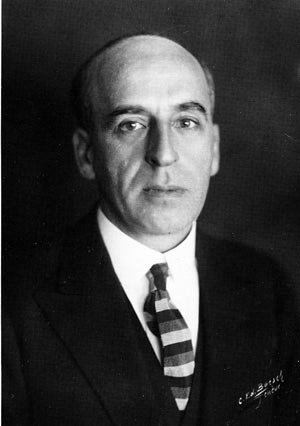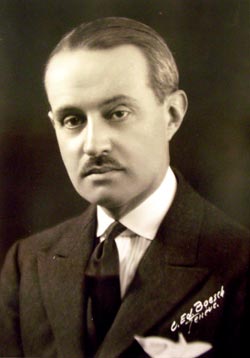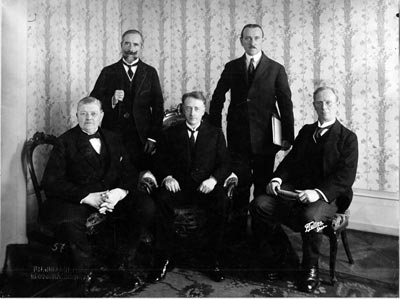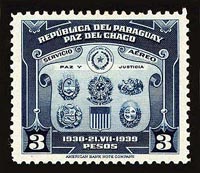|
Abstract
Ireland and the Latin American states shared many features in the international negotiations at the League of Nations. In particular, they positively asserted their national independent status in their relationship with the organisation. To illustrate this, this article covers the role played by Sean Lester in the resolution of the Chaco and Leticia conflicts.
|

Sean Lester (1888-1959)
(United Nations Library, Geneva, League of Nations
archives) |
Born
from the rubble of World War One, the League of Nations
(LoN) was founded in 1920 at the instigation of United
States President Woodrow Wilson, and became the first
international organisation with a global scope. Its major
goals included the building of a lasting peace, and cooperation
among nations. The LoN’s original undertaking was connected
with the aftermath of the global conflict and the European
political situation. However, most of the Latin American
states were founding members of the organisation (2). The Irish Free State was admitted in 1923 and shared
a similar situation with the Latin American members. They
all based their diplomatic strategies on the LoN, aiming
to assert their national independence and to establish
contacts with a large number of nations. The first part
of this article deals with the relations between the Irish
and Latin American delegations. These relations intensified
when the LoN investigated two regional conflicts, the
Chaco War between Bolivia and Paraguay, and the dispute
between Colombia and Peru over the Leticia territory.
In the context of both events, Ireland’s delegate Sean
Lester played a key role, which is examined in the second
part of the article with the objective of determining
whether he acted on behalf of his government or to support
the LoN’s moral and legal principles.
The Anglo-Irish Treaty was signed in 1921 to establish a dominion known as the Irish Free State, yet foreign policy continued to be the responsibility of the British Foreign Office. Nevertheless, the development of foreign relations is one of the aspects of state sovereignty and the aspiration of all independent nations. Article 1 of the Covenant of the LoN offered member status to ‘any fully self-governing State, Dominion or Colony […] provided that it shall give effective guarantees of its sincere intention to observe its international obligations […]’. For Ireland, the LoN represented both an opportunity to gain international recognition, and a space to develop its foreign policy through independent voting rights from those of the British Empire.
Already in 1919, Sinn Féin recognised that the LoN (then still a project) could be a forum for the internationalisation of the Irish aspiration towards independence. The creation of the LoN was approved at the Paris Peace Conference, where Sinn Féin wanted to introduce the Irish question. This did not prove possible and the Sinn Féin leaders lost their interest in the LoN, favouring a bilateral strategy. It was not until the Anglo-Irish Treaty of 1921 and freedom from strife after the Civil War that the Irish Free State could join the LoN on 10 September 1923 (Kennedy 1996: 13-20). On this occasion, the permanent delegate of the Irish delegation entered the conference room of the LoN Assembly and delivered an important speech marked by its symbolic significance. The first sentences were rendered in the Irish language, not in English, strongly indicating the Irish national identity and the independence that its leaders aspired to enjoy at the LoN.
The
LoN played the same role for many Latin American nations.
Indeed, their sovereignty was already recognised as independent
states. Yet they feared for their sovereignty because
of the military involvement of the US in Haiti, the Dominican
Republic and Nicaragua, or by treaties authorising intervention,
such as the Platt Amendment in Cuba and the 1903 treaty
with Panama. For the nations of this region, participation
in the LoN offered a vehicle to restate their independence.
The Covenant of the LoN guaranteed the territorial integrity
and the independence of the member states. Furthermore,
as mentioned above, pursuing a foreign policy is a way
of asserting sovereignty. For that reason, in spite of
the occupation of Haiti by the US marines (which lasted
until 1934), from 1920 the former country sent a delegation
every year to the Assembly meetings. Furthermore, in 1930
the Haitian delegation overtly condemned the US occupation.
In the Dominican Republic, once the US forces left the
country in July 1924, the first action taken by the Republic
was to request accession the LoN, which was effected in
September of the same year (Wehrli 2008).
There was another advantage to participating in the LoN negotiations. Establishing links with delegations from more than fifty states was not an insignificant opportunity. Countries like Ireland were in the process of gaining independence and lacked their own diplomatic representations. The Latin American governments lacked the necessary budget to develop an extensive network and only had a few legations, typically in Washington, London, Paris, Madrid, Rome, Berlin and in some neighbouring countries. In fact, it was at the LoN that the first ‘diplomatic relations’ were established between Ireland and Latin America.
In fact, those relations were not particularly close. However, the Latin American delegations supported the election of Ireland to the Council in 1930. At that opportunity, they recalled the links between Ireland and Latin America, including the soldiers who fought with the
Libertadores during the Wars of Independence, and the immigrants who in the nineteenth century contributed to the development of these nations (Kennedy 1996: 130-141). However, it was during the resolution of the Chaco and Leticia conflicts that the Irish delegates - in particular Sean Lester - and those of four Latin American states were to work together.
The
Chaco War (1932-1935)
During
the second half of the nineteenth century, the Chaco territorial
dispute between Bolivia and Paraguay spoiled relations
between the two countries. In July 1932, the conflict
worsened and became an armed engagement. In the earlier
stages of the Chaco War, the LoN delegated the negotiation
to the Neutral Commission, including six governments of
the Americas and led by the US. From 1929, the Neutral
Commission had been trying to ameliorate the conflict.
Nevertheless, in September 1932 the LoN Council recognised
that the situation was rather worrying and appointed a
three-member committee - ‘The Committee of Three’ - to
analyse the war’s evolution and, if needed, to prepare
the LoN’s intervention. Actually, according to Article
11 of the Covenant the LoN could not intervene on its
own without having been called upon to do so by a member
state. At that time, Ireland was responsible for the presidency
of the Council so its delegate was the president of the
committee. Sean Lester, together with the delegates of
Spain and Guatemala, Salvador de Madariaga and José Matos
respectively, acted on behalf of the Council during all
the instances of the LoN mediation in this conflict, and
tried to sort out the irreconcilable positions of the
Bolivian delegate Adolfo Costa du Rels, and his Paraguayan
counterpart, Ramón Caballero de Bedoya.
|

Adolfo Costa du Rels
(1891-1980)
(United Nations Library, Geneva,
League of Nations archives) |
In
early 1933 the situation had been clearer. In February,
the most influential powers in the LoN, France and Great
Britain, recommended an arms embargo on the warring parties.
The Committee of Three was in charge of presenting a report,
and Sean Lester evaluated it as a relevant proposal. However,
the problem was that the LoN could not take a decision
without a formal request from a member state. In March
1933, the three members of the Committee placed the Chaco
War on the Council’s agenda, therefore authorising the
execution of concrete resolutions. In a letter dated 4
March 1933 addressed to the Secretary of Foreign Affairs
in Dublin, Sean Lester wrote ‘We have been making history
in Geneva this week’, and explained the actions undertaken
by the Council. ‘For the first time […] arrangements are
in progress for the declaration of a League embargo on
arms for two countries, Bolivia and Paraguay, and, I think
also for the first time, three states will exercise their
friendly right in invoking Article XI in a dispute between
two other countries’ (LONA, PSL). Regrettably, within
the context of the economic crisis, major state-run arms
exporters refused to apply the embargo if it was not generalised,
which included the US and other non-member states. However,
the US senators rejected a law authorising the President
to declare an embargo, therefore it could not be established.
It was not until the summer of 1934 that the embargo was
established, including the participation of the US.
In
May 1933 the state of affairs became even worse when Paraguay
declared war, though the declaration was a mere confirmation
of the de facto situation. The Council decided to increase
their pressure. After lengthy negotiations, the Committee
of Three was authorised by the parties to send a reconnaissance
mission to Chaco. The mission was delayed by the decision
of the parties in June to accept arbitration by the neighbouring
countries (Argentina, Brazil, Chile and Peru). The failure
of this arbitration allowed the departure of the mission,
which arrived in Chaco on November 1933. Ireland’s presidency
of the Council ended its mandate in September, so Sean
Lester ceded his post on the Committee of Three to the
Czechoslovakian delegate and the presidency to the Mexican
Francisco Castillo Nájera. It was not until June 1935
that a ceasefire was reached with the support of the neighbouring
countries instead of the LoN.
The
Colombian-Peruvian War (1932-1933)
Rather
more successful was the LoN intervention and Sean Lester’s
action in the resolution of the conflict between Peru
and Colombia for the Amazonian territory of Leticia. The
Salomón-Lozano Treaty of 1922 (ratified in 1928) made
provisions for the swapping of territories between Peru
and Colombia. Colombia would have direct access to the
Amazon River and therefore possess the town of Leticia
and adjacent territory. However, on 1 September 1932 a
group of armed Peruvian civilians seized the Amazonian
harbour of Leticia in a demonstration against the Salomón-Lozano
Treaty and expelled the representatives of the Colombian
state. After some days, the Peruvian government despatched
forces to support the rebels, and the hostility increased
between Lima and Bogotá. In January 1933, Colombia requested
the intervention of the LoN. The Committee of Three and
its president Sean Lester were already working for peace
in Chaco, and were appointed as negotiators between Peru
and Colombia. The former country was represented by the
renowned intellectual Francisco García Calderón. His Colombian
counterpart, Eduardo Santos, was the owner of the liberal
newspaper El Tiempo and would later be Minister of Foreign
Affairs and Colombian President. Lester led the discussions
and managed to reach a satisfactory resolution. Since
the Council had acknowledged the validity of the Salomón-Lozano
Treaty, the goal was to convince the Peruvian forces to
withdraw. Furthermore, Leticia would be placed under the
control of the LoN and returned to Colombia at a later
stage.
|

Irish Delegation to the
League of Nations, 1923
(United Nations Library, Geneva, League of
Nations archives) |
However, since the Peruvians could not revoke the Treaty, they sought to revise it. Therefore, they proposed holding a conference focusing on this dispute. During the conference, Leticia would be protected by international forces led by the LoN, and returned to Peru or Colombia according to the decisions taken there. Yet the Colombians believed that only their soldiers should set foot
in Leticia. They did not accept the presence of an international force, though they would agree to hold the conference. Confronted with these opposing stances and aside from the negotiations, Sean Lester tried to establish an arms embargo against Peru if its government continued presenting unreasonable demands. In May, this approach proved to be unnecessary because a resolution was adopted thanks to Lester’s conciliatory expertise. The settlement included one-year administration of Leticia by an LoN commission. During this period, a conference would be held with the purpose of making lasting decisions about the borders between Colombia and Peru and the free navigation of the river Amazon and its tributaries. In order to maintain order, the Commission would send international troops to the area, although Lester and the Colombian and Peruvian representatives decided through confidential correspondence that the troops would be from Colombia. Therefore, Lima was able to save face and Bogotá’s demands were fulfilled. As for the LoN,
it came out of the ordeal with increased stature.
Sean Lester received several compliments and congratulations for his work, which also helped to strengthen Ireland’s international reputation. In the July 1933 issue of
Concorde, a publication of the Irish League of Nations Society, an article remarked upon ‘an instance - of which little notice was taken by the press in this country - in which it can be seen how opportunities of a unique and honourable kind are given to our countrymen to render splendid services to other nations through our membership of the League’ (LONA, PSL).
What was the actual role played by Dublin through Sean Lester’s activities? From September 1933, Lester had witnessed the poor performance of the Council during the Manchuria affair and its inability to end the Japanese occupation (Barcroft 1973: 26-43). He reckoned that the Chaco and Leticia disputes provided the LoN with an opportunity to restore its reputation and to showcase its efficient operation. Therefore, as Michael Kennedy observed, ‘Lester’s actions were taken without seeking advice from Dublin; they were matters of League and not national policy. He was acting as President of the Council, not Irish Permanent Representative’ (Kennedy 1996: 177). Most of the time, Lester proceeded on his own initiative and without instructions from his superiors, and just reported to them on the development of his mission. Indeed, he obtained his government’s support regarding the embargoes. But Dublin would have preferred him to act with more prudence (Kennedy 1996: 179). Sean Lester’s main objective was to defend world peace and the interests of the LoN. In this way, he gained significant prestige in diplomatic circles and was successively appointed High Commissioner in Danzig
(Gdańsk) in late 1933, Deputy Secretary-General in 1937, and Secretary-General in 1940. According to Kennedy, ‘these two disputes show Lester metamorphosing into an international civil servant’ (Kennedy 1996: 177).
In
spite of the lengthy negotiations, Sean Lester had good
contacts with at least two Latin American delegates. In
September 1938, he wrote in his diary of Francisco García
Calderón: ‘Catholic poet, and orator, like so many Latin-Americans:
a man of culture. We are friends since I presided over
the Peru-Colombia Committee about six years ago’ (LONA,
DSL). During World War Two, acting as Deputy Secretary-General,
Lester also maintained a good relationship with Costa
du Rels, who was the President of the Council. Furthermore,
in July 1940, Costa du Rels supported Lester’s appointment
as Secretary-General, succeeding the French diplomat Joseph
Avenol. (3)
Conclusion
Ireland and a number of Latin American states lacked an extensive diplomatic network, but were able to use the LoN as a platform to assert their independence and to make their case known in the international context. Their contacts increased through the activity of Sean Lester, in particular during the Chaco and Leticia conflicts. Lester acted with great autonomy yet officially represented the Irish state, and operated above all as an international civil servant. During this period the Latin American diplomats were less in connection with Ireland than with an Irishman.
Yannick Wehrli
Notes
1
Lecturer in history at the University of Geneva.
2
Among the founding members of the League of Nations were
Guatemala, Honduras, Nicaragua, Panama, Bolivia, Brazil,
Ecuador, Peru, Uruguay, Haiti and Cuba. Among the states
invited to accede to the Covenant were Argentina, Chile,
Colombia, Paraguay, El Salvador and Venezuela.
3 Joseph
Avenol (1879-1952) was forced to resign by the Vichy Government,
which wished to discontinue relations with the LoN. Avenol
was reluctant to leave his job (Barros 1969: 252-4).
References
- Barcroft, Stephen Ashworth, The international civil servant: the League of Nations career of Sean Lester, 1929-1947 (Dublin: unpublished M.A. History, 1973).
- Barros, James,
Betrayal from within: Joseph Avenol, Secretary-General of the League of Nations, 1933-1940 (New Haven and London: Yale University Press, 1969).
- Gageby, Douglas, The last secretary general: Sean Lester and the League of Nations (Dublin: Town House, 1999).
- Herrera León, Fabián, La política exterior mexicana en la Sociedad de Naciones ante la Guerra del Chaco y el conflicto de Leticia, 1932-1935 (Mexico D.F.: Secretaría de Relaciones Exteriores, forthcoming).
- Kennedy, Michael, Ireland and the League of Nations 1919-1946: politics, diplomacy and international relations (Dublin: Irish Academic Press, 1996).
- League of Nations Archives, Geneva, Diary of Sean Lester (LONA DSL).
- League of Nations Archives, Geneva, Papers of Sean Lester (LONA PSL).
- Wehrli, Yannick, ‘Egalité des races et indépendance nationale. Haïti à la Société des Nations’ in
Journée en l’Honneur du Prof. Antoine Fleury, 21
November 2008, unpublished.
- Wehrli, Yannick, ‘La multiplicité des intervenants dans la résolution pacifique du conflit du Chaco (1932-1935) : un obstacle à la paix ?’ in: Vincent Chetail, Vincent Van der Poel, Syvie Ramel and René Schwok (eds.), Préventions, gestion et sorties des conflits (Geneva: Euryopa, 2006).
|




